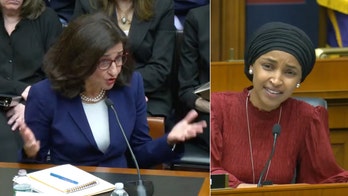When I think about the ballooning size of the federal budget, deficit and national debt, I’m often reminded of the Broadway musical “Little Shop of Horrors” and its blood-sucking plant “Audrey II.”
For the uninitiated, Little Shop of Horrors centers on down-and-out Seymour Krelborn. He lives on skid row. He works at a decrepit flower shop where he tends to a pathetic, little plant “stuck in among the zinnias.” Seymour names the plant “Audrey II” after a woman he’s fallen for.
The plant resembles a cross between a pistachio shell and a venus fly-trap. It simply won’t grow. Until Seymour pricks his finger on a thorn and begins to bleed. At that point, Audrey II laps up the blood and begins to blossom. After a while, a few nips of blood each day aren’t enough for Audrey II. It quickly matures into a gigantic pod lined with piranha teeth. The beast snaps for food. Soon, its roots and tendrils coil around the flower shop as Audrey II grows to monstrous size.
The plant’s craving for blood burgeons. It begins to speak and sing. Audrey II finally demands that Seymour murder someone to satiate its appetite for plasma.
“The guy sure looks like plant food to me,” it hints to Seymour.
Audrey II evolves into a botanical leviathan. It requires Seymour feed it constantly. He can’t keep up. The creature develops a ‘tude.
“I’m mean and green,” Audrey II crows, “And I am bad!”
Pretty soon, the beast cows Seymour into doing almost anything to keep it fed. Audrey II multiplies in size.
Which brings us to the challenge facing policymakers who are trying to grapple with the explosion of federal spending.
For fiscal year 2010, the government spent more than $3.7 trillion. About $1.4 trillion of that is what Congress calls “discretionary” spending. That means Congress can decide whether to spend it or not. Anything ranging from a new weapons system at the Pentagon to purchasing computers at the Agriculture Department. The $2.3 trillion balance of that money is “non-discretionary.” That means Congress has no say in whether it pays it each year. Technically, Congress does. But that would be political suicide. After all, non-discretionary money goes for entitlement programs like Social Security, Medicare and Medicaid. It also services America’s debt.
The estimates for fiscal year 2011 have Washington operating a $3.8 trillion budget. $1.4 trillion is discretionary. $2.4 trillion is non-discretionary.
People around the country are apoplectic about government spending. That’s a message propounded by former Alaska Gov. Sarah Palin (R). And it’s one of the reasons why the anti-spending messages of Republican senatorial nominees Rand Paul and Sharron Angle resonated in Kentucky and Nevada.
Last week, President Obama asked all government agencies to slash their budgets by five percent. To accomplish this, the White House told federal departments to eliminate unnecessary programs, reorganize staff and purchase supplies in bulk. The president’s goal is noble. But at the end of the day, five percent of $3.8 trillion is only $76 billion.
There’s an urban myth that the late-Senate Minority Leader Everett Dirksen (R-IL) uttered one of the best-known phrases in American politics: “A couple million here and a couple million there and pretty soon you’re talking about real money.”
No one can trace any evidence of Dirksen having said such a thing. But regardless of who said it, even “a couple billion here and a couple billion there” won’t do the trick. Budget hawks have to move the decimal point to trillion before they’re “talking about real money.”
One valiant effort to trim the budget comes from House Minority Whip Eric Cantor (R-VA). Cantor’s aides have engineered a contest called “YouCut” where the public can vote on a slate of potential programs to slash. The first “winner” was an idea to kill $2.5 billion of emergency welfare aid. Other YouCut projects include a plan to eliminate federal pay increases to the tune of $2 billion next year. Another would realize $30 billion in savings generated by reforms at Fannie Mae and Freddie Mac. The idea that’s polling well this week would force the government to sell off $15 billion in unused real estate.
Again, $30 billion is hard for the average American to fathom. Even $2 billion is hard to swallow. But add those ideas together and you quickly have proposed cuts of nearly $50 billion. Still, when reducing the budget. that’s a drop in the bucket. Especially when the majority of the government’s outlays are non-discretionary expenditures stemming from entitlements and interest on the debt.
Which is the problem. Cutting discretionary spending helps. But only a little.
Meantime, detractors decry YouCut as a GOP gimmick and say it doesn’t slice deeply enough. But the effort certainly reveals the depth of the crisis. Even targeted, bona fide proposals to hack the budget don’t make much difference.
Which is downright scary.
All of this comes on the heels of a bizarre, Saturday night letter from Mr. Obama to Congressional leaders calling for $50 billion in emergency funding for school teachers, law enforcement and firefighters. The president wants to Velcro that spending on top of a $141 billion bill to extend tax credits that’s now before the Senate. But even the Congressional brass had to pare that measure back in the House to satisfy fiscally-conscious “Blue Dog” Democrats. The Senate just okayed a $60 billion “supplemental” spending bill to fund the wars in Iraq and Afghanistan. It’s called a “supplemental” because it’s on top of what was already budgeted for this year. Attached to that legislation was aid for Haiti and relief money for flooding in Tennessee.
The House hasn’t touched the supplemental bill yet. But it’s likely the size could grow. Since the Senate tackled the issue, floods have ravaged Arkansas and tornadoes tore through northern Ohio. The recovery assistance will climb into the millions of dollars. And few lawmakers will begrudge their colleagues from those regions help to cover natural disasters. That’s because later this year, there will be forest fires in the west, floods in the Midwest and hurricanes along the coast. And then the lawmakers who represent those areas will come to the federal treasury with hat in hand. And no one can blame them.
The U.S. budget and deficit are juiced to such levels that even Draconian cuts wouldn’t return the federal treasury to solid footing. Like Seymour feeding Audrey II, the U.S. continues to feed the beast. And it grows out of control.
The final tune in Little Shop of Horrors offers a simple but direct message.
“Whatever they offer you, don’t feed the plants,” the chorus warns.
Washington fed the plants for years. As a result, they swelled to absurd sizes and became nearly indestructible.
“You don’t know what you’re dealing with. No, you never did,” Audrey II scoffs at Seymour.
The only way to conquer the creature is to completely starve it. And even in tough fiscal times, there’s not much appetite for that.




